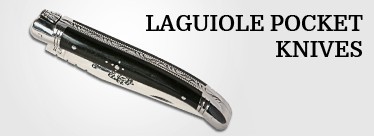Cutler's Advice

What steel to choose ?
Carbon steel
Originally "carbon steel" was used by the cutlers.
The high carbon content improves the cutting performance and makes the blade easier to sharpen.
However over time the blade can change color and go black. This is quite Normal and harmless.
Carbon steel knives also rust very easily.
Consequently these knives need careful and thorough upkeep.
Stainless steel
Nowadays the cutlers prefer to use 12C27 stainless steel.
This type of steel provides a good compromise between the knife's cutting performance and corrosion resistance.
Whether stainless steel or carbon steel, a knife is above all a fragile utensil that needs regular care.
Damask
Originally, Damascus is a way of iron refining by hammering, folding and drawing, in order to get rid of the impurities of metal.
Thus a composite material is created having more or less homogeneous layers in turns, usually iron and nickel or nickel and steel. The Damascus knives for sale on our site all have a Damascus steel blade composed of 120 layers.
This heterogeneous texture induces rather exceptional mechanical qualities (neither iron nor nickel can be tempered) because Damascus can only be tempered partly.
So metal is little breakable and stands the breaking since it diffracts the shock-waves.
Tours
Thiers is remarkably well situated in the Livradois-Forez Regional Natural Park.
The architectural beauty of the old town of Thiers, built into the side of the rock, makes it one of the Auvergne and an important center of European cutlery making .
To know all about the marriage of iron, fire and water, please take time to visit :
The cutlery museum in Thiers
In its workshops, before your very eyes, a sharpener, an assembler, a polisher are at work producing up-market knives.
You will also discover a fabulous collection of knives, from yesterday to today, from princes to peasants.
Discover the history of knifemaking in the Thiers region by taking a trip to :
La vallée des Rouets
Driving down this valley, you can retrace the tracks of the knife-grinders, well known for working in a horizontal position, lying on the board above their grindstones








